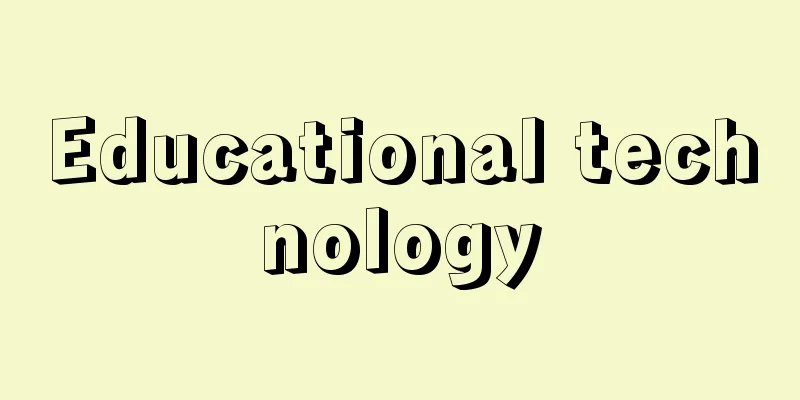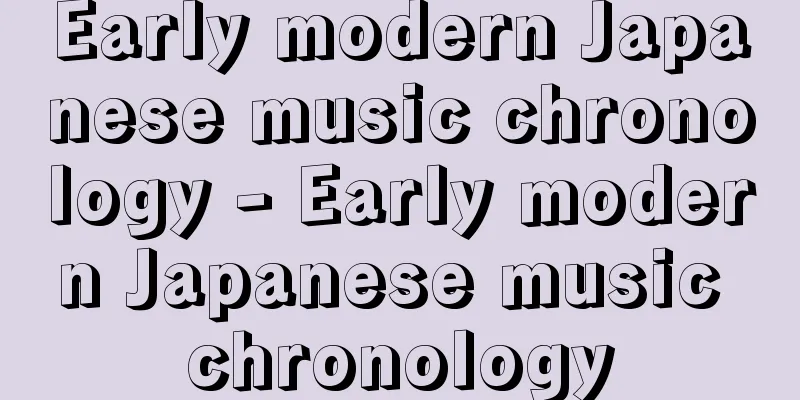Educational technology

|
It has been used in Japan since the early 1960s, but there are various views on its definition and there is no consensus. However, as the name suggests, it is commonly understood that it is a field of pedagogy that studies and practices the introduction of the results of engineering technology into education, improving educational methods (especially methods that take into full consideration the content of lessons and the children and students who are the target audience) to maximize their effectiveness. Originally, engineering was a branch of natural science alongside science, but just as science focuses on natural phenomena within materials and objects, engineering focuses on natural things within social phenomena and attempts to elucidate them through a systems approach. The systems approach is a methodology that aims to achieve a goal by analyzing all the elements involved in achieving a goal, clarifying the relationships of dependency and independence between each element, and optimally designing the conditions of each element as well as the combination of each element. The system approach is effective because (1) in modern society, society has become large and complex, and partial and partial solutions to problems cannot adequately cope with these changes, and (2) with the development of information processing sciences, such as cybernetics and OR (Operations Research) by the American mathematical philosopher N. Wiener, and electronics, quantification and rigor of problems are required and control of these problems is possible. On the other hand, behavioral science has also developed theories of development and learning, focusing on human behavior. Since the mid-1980s, there has been a shift to research on cognitive theories, such as social constructivism (a constructivist position that emphasizes relationships with society), but there is no doubt that behavioral science theory is at the origin of the theory. Thus, the introduction of a systems approach to education and efforts to increase the scientific nature of education, i.e. reproducibility, rationality, systematicity, and objectivity, have been largely lacking in practical research on education up until now. In this sense, a systems approach to education, or educational technology, can make a significant contribution to the improvement of educational methods, particularly the improvement of classes. [Shinohara Fuyoji] Educational Technology and ClassesThe basis of educational technology is to apply a systems approach to the teaching and learning process and to systematize not only classes but education in general in order to achieve educational goals effectively and efficiently. First, the prerequisites necessary for attending the class are met in the students. Next, information (teaching materials) that embodies the educational content (teaching content for teachers, learning content for students) is presented and the students accept this. At this time, the desired response is not necessarily formed immediately, so various information is presented to reinforce the response. The teacher individually collects the state of the reaction thus formed, diagnoses whether it is a desirable reaction or not, and based on this, communicates information on the development and correction of the learning content and attitude of the child/student, as well as treatment, so that the child/student can correct themselves individually. Feedback is given at every stage in the communication process of this series of situations. In addition, educational devices are used in the right places and with the right equipment when transmitting information. What is important here is to clarify the goal as a target behavior in order to achieve the goal efficiently, to accurately grasp the reaction of the child/student, to form a reaction that can be accurately grasped, and to give the child/student accurate feedback immediately. As mentioned above, modern educational technology regards lessons as a system, focuses on lesson design, implementation, and evaluation, and seeks to clarify the interrelationships between the human and material resources involved in these areas, empirically resolves the various educational problems that lie in classroom management, school management, and more broadly, and scientifically translates into various educational phenomena. However, it is unfortunate that attention tends to be focused only on the introduction of new means such as the Internet and multimedia, with no consideration at all to the children and students who are the targets of education and lessons, or to the educational content, and that a "just create a box and that's it" trend can be seen. [Shinohara Fuyoji] Educational Technology and Educational EquipmentUnderstanding lessons as a system requires teaching tools, which were advocated at the height of the so-called audiovisual education movement, to have not only a simple presentation function but also reaction, evaluation, and control functions to oversee these. The progress and development of electronics and educational theory accelerated this trend, and it can be said that the term "educational equipment" was created. From the 1960s to the latter half of the 1970s, in response to the advanced industrial society, easy-to-operate educational equipment, computer-controlled CAI (Computer Assisted Instruction) and CMI (Computer Managed Instruction), which were thought to be capable of automating educational activities just like society, appeared and were used. However, as seen in the "New View of Academic Ability" of the Course of Study announced in 1989, and the "Development of Life Skills" of the Course of Study in 1998 and 1999, which are characterized by the introduction of the "Five-Day School Week" and the "Integrated Study" period, the educational goals have changed significantly from the previous "efficient education" to the development of "ability to think, judge and express". As a result, these systems have gradually fallen out of use. Rather, since new information environments such as the Internet and multimedia are more effective in achieving these goals, the use of educational equipment such as computers, including software, has become more widespread in order to enhance learning based on the "interests, concerns and motivations" of each child and student, as typified by "research learning". However, there is no doubt that greater use of CAI systems would be effective in "improving the basics" centered on subject education. When the concept of teaching tools and educational equipment was first established, its aim was to serve as auxiliary tools that would enable teachers and students to achieve educational goals effectively and efficiently, while allowing for deeper thinking and delicate emotional exchanges between them in the teaching and learning process. This is exactly the aim of educational technology, and it is necessary to give it careful consideration when introducing and utilizing new information environments. [Shinohara Fuyoji] "Educational Technology," edited by Nakano Terumi (1979, Gakken)" ▽ "The Complete Works of Education 30: The Process of Lessons," by Nishinozono Haruo (1981, Daiichi Hoki Publishing)" ▽ "Educational Technology Series for Applying to Lesson Practice," 6 volumes, by Ouchi Shigeo and Nakano Terumi (1982, Japan Tosho Bunka Kyokai)" ▽ "How the Internet Will Change Education," edited by the Japan Society for Educational Technology (1999, Meiji Tosho Publishing)" ▽ "Reexamination of the View of Academic Ability and Reform of Lessons," edited by the Japan Society for Educational Methods (2001, Tosho Bunka Publishing)" [References] | | | | | | | | |Source: Shogakukan Encyclopedia Nipponica About Encyclopedia Nipponica Information | Legend |
|
昭和40年代の初めころからわが国で使用されるようになったが、その概念規定についてはさまざまな見解があり、定説はない。しかし、その名が示すように工学技術の成果を教育に導入し、教育の方法(とくに授業の内容とその対象である児童・生徒に十分に配慮した方法)を改善し最大の効果をあげることを研究、実践するための教育学の一分野であることに、共通の了解が得られている。 もともと工学は理学と並んで自然科学の一部門であるが、理学が物質や物体のなかの自然現象を対象とするように、工学は社会事象のなかの自然的なものを対象とし、これをシステム・アプローチsystems approachで解明しようとする。システム・アプローチとは、目標の実現に参画するすべての要素を分析し、各要素間相互の依存・独立の関係を明らかにし、各要素の条件ならびに各要素の組合せを最適に設計して、目標を実現しようとする方法である。 システム・アプローチが有効なのは、(1)現代社会においては、社会規模が大規模・複雑化し、事象の局面的・部分的解決ではその変化に十分対応できないこと、(2)情報処理諸科学、たとえば、アメリカの数理哲学者ウィーナーN. Wienerによるサイバネティックスcybernetics、OR(オペレーションズ・リサーチOperations Research)などやエレクトロニクスの発展に伴い、事象の数量化と厳密化が要請されるとともに、これを制御することが可能になってきたこと、などが考えられるからである。一方、行動科学も、人間の行動を対象とし、発生・発達理論や学習理論を発展させてきた。1980年代のなかばからは社会的構成主義Social Constructivism(社会とのかかわりに力点を置く構成主義の立場)に代表される認知理論の研究に移行しつつあるが、行動科学理論がその原点に存在することに疑いの余地はない。 このように、システム・アプローチを教育に導入し、教育における科学性、すなわち再現性・合理性・体系性・客観性を高める努力は、これまでの教育の実践研究においては大きく欠けていたことである。その意味で、教育へのシステム・アプローチすなわち教育工学は教育方法の改善とくに授業の改善に大きな貢献をするものである。 [篠原文陽児] 教育工学と授業教育工学の基本は、教育目標を効果的、効率的に達成するために、教授・学習過程にシステム・アプローチを適用し、授業はもとより教育全般をシステム化することである。まずその授業を受けるのに必要な前提条件を児童・生徒に充足する。次に教育内容(教師にとっては教授内容、児童・生徒にとっては学習内容)を具体化した情報(教材)を提示し、児童・生徒がこれを受容する。その際、即時に望ましい反応を形成するとは限らないので、反応を強化するためのいろいろな情報を提示する。 こうして形成された反応の状態を教師が個別に収集し、それが望ましい反応か否かを診断し、これに基づいて児童・生徒の学習内容や態度等の発展・修正、治療の情報を伝達して、個々に自己修正させる。これら一連の状況のコミュニケーション過程の随所でフィードバックが行われていく。また情報の伝達にあたっては、教育機器が適材適所で活用されていく。このときたいせつなことは、目標を効率的に達成するため、目標を目標行動として明確化することと、児童・生徒の反応を的確にとらえること、また的確にとらえられるような反応を形成すること、そして即時に児童・生徒に対し的確なフィードバックを与えることである。 以上のように、授業を一つのシステムとしてとらえ、授業の設計・実施・評価を中心として、これらに関与する人的・物的資源など相互の関係を明らかにし、広くは学級経営、学校経営などに潜む教育の諸問題をも実証的に解決し、教育の諸事象を科学化しようとするのが、現代の教育工学である。しかし、ややもすればインターネットやマルチメディアなど新たな手段を導入することのみに注意が向けられ、教育や授業の対象である児童・生徒、また教育内容についてまったく考慮しないような「箱ものをつくっておしまい」という風潮が見受けられるのは残念なことである。 [篠原文陽児] 教育工学と教育機器授業をシステムとしてとらえることは、いわゆる視聴覚教育の運動の高まりのころに唱えられていた教具に、単なる提示機能だけでなく、反応、評価、そしてこれらを統括する制御機能を求めることになる。エレクトロニクスや教育理論の進歩・発展がこの傾向に拍車をかけることになり、「教育機器」という用語をつくりだしたといえる。1960年代から70年代の後半にかけては、高度産業社会に対応し、社会のオートメーション化と同様、教育活動についてもオートメーション化が可能だと考えられるような、操作性のよい教育機器や、コンピュータで制御されるCAI(Computer Assisted Instruction)、CMI(Computer Managed Instruction)などが出現して活用された。しかし、1989年(平成1)に告示された学習指導要領の「新しい学力観」や、「学校週5日制」と「総合的な学習」の時間の新設を特徴とする98年および99年の学習指導要領における「生きる力の育成」にみられるように、かつての「効率化された教育」から「思考力・判断力・表現力」の育成に教育目標が大きく変化した結果、これらのシステムはしだいに活用されなくなってきている。むしろ、インターネットやマルチメディアなど新たな情報環境がこうした目標の達成に有効であることから、「調べ学習」に代表されるような児童・生徒それぞれの「興味・関心・意欲」による学習を充実させるため、ソフトウェアを含めたコンピュータなどの教育機器の活用が盛んになってきている。ただし、教科教育を中心とした「基礎・基本の充実」においては、CAIシステムのいっそうの活用が有効であることは間違いない。 教具や教育機器が、その概念の成立当初ねらったことは、教師と児童・生徒間の思考の深化や感情の細やかな交流を教授・学習過程のなかに残しつつ、教育目標を効果的、効率的に達成させる補助的な道具としての存在であったはずである。教育工学のねらいもまさにここにあるのであり、新たな情報環境の導入と活用にあたっても十分に検討する必要がある。 [篠原文陽児] 『中野照海編『教育工学』(1979・学習研究社)』▽『西之園晴夫著『教育学大全集30 授業の過程』(1981・第一法規出版)』▽『大内茂男・中野照海著『授業実践に生かす教育工学シリーズ』全6巻(1982・日本図書文化協会)』▽『日本教育工学会編『インターネットが教育を変える』(1999・明治図書出版)』▽『日本教育方法学会編『学力観の再検討と授業改革』(2001・図書文化社)』 [参照項目] | | | | | | | | |出典 小学館 日本大百科全書(ニッポニカ)日本大百科全書(ニッポニカ)について 情報 | 凡例 |
<<: Educational civil servant - Kyoiku Koumuin
Recommend
Takasago [city] - Takasago
A city on the west bank of the mouth of the Kakoga...
Precipitation hardening
When a supersaturated solid solution is aged, it u...
Oberkamp - Oberkamp
…In England, woodblock printing was put to practi...
International Association of Hydrological Sciences
...The field of research into hydrological cycles...
Retina - Momaku (English spelling)
The retina is the innermost membrane of the eyeba...
Oxidant (English spelling)
A general term for highly oxidizing substances suc...
Cephalopterus ornatus (English spelling) Cephalopterusornatus
…They are found in the tropical regions of Centra...
Lippmann
German-born American biochemist. He studied at th...
Equitable Society
...The Roman Empire's burial funds, the sickn...
Praise for the way of life - Gyodosan
...There is also considerable diversity, such as ...
Mirage - Shinkiro
A phenomenon in which the direction in which an o...
Glasscobo Culture - Glasscobo Culture
An early Bronze Age culture in Trans-Baikal, Russi...
Takaba
A place set up by a certain person of power for t...
Takada [town] - Takata
A former town in Miike County, southern Fukuoka Pr...
Haley, B.
… Rhythm and blues is a type of popular music for...









